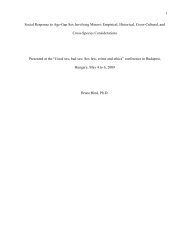Infant and Child Sexuality: A Sociological Perspective - Ipce
Infant and Child Sexuality: A Sociological Perspective - Ipce
Infant and Child Sexuality: A Sociological Perspective - Ipce
Create successful ePaper yourself
Turn your PDF publications into a flip-book with our unique Google optimized e-Paper software.
completely missing. These findings support the assumption that during<br />
the first year of life autoerotic activities vary with the nature of<br />
the relationship between the infant <strong>and</strong> those with whom he has intimate,<br />
affectional encounters.<br />
Sears (1957) reports another behavioral pattern associated with inadequate<br />
infant-mother encounters. A relatively cold <strong>and</strong> undemonstrative<br />
attitude toward the infant, combined with high sexual anxiety on<br />
the part of the mother <strong>and</strong> severe toilet training, were “most efficient<br />
in producing prolonged bed-wetting.” Severe toilet training increased<br />
the amount of upset in children whose mothers were relatively<br />
cold <strong>and</strong> undemonstrative. However, the mother’s “coldness” per se did<br />
not appear to upset the child; “coldness” had to be manifested overtly,<br />
through severe training practices, before it produced the noted disturbances<br />
in behavior. On the other h<strong>and</strong>, Sewell (1953) found in a study<br />
of 5-6 year old children that the personality adjustment <strong>and</strong> traits of<br />
those who had varying infant-adult encounters did not differ significantly<br />
from each other. Personality adjustment <strong>and</strong> traits of children<br />
did not differ significantly whether or not as infants they were suckled<br />
or bottle fed, fed on a self-dem<strong>and</strong> schedule or on a regular schedule,<br />
weaned gradually or weaned abruptly, introduced to bowel training<br />
early or late, introduced to bladder training early or late, were not<br />
punished for toilet training accidents or were punished, slept with<br />
their mothers during infancy or did not sleep with their mothers. Personality<br />
adjustment <strong>and</strong> traits of children whose infantile security appeared<br />
to be favorable did not differ significantly from those of<br />
children where it appeared to be insecure. Personality adjustment <strong>and</strong><br />
traits of children whose toilet training experience appeared to be favorable<br />
did not differ significantly from those of children whose<br />
scores were unfavorable, <strong>and</strong> personality adjustment <strong>and</strong> traits of children<br />
whose feeding training appeared to be favorable did not differ<br />
significantly from those of children whose scores were unfavorable. The<br />
findings of Spitz <strong>and</strong> Sewell are not directly comparable, but they do<br />
point out the need for additional research.<br />
It is evident from studies of mammals that intimacy, attachment,<br />
caressing, fondling, <strong>and</strong> genital play are outcomes of involvement of<br />
parent <strong>and</strong> infant. Among humans, infants with adequate affectional relations<br />
play with their genitals. A minority of infants not only play<br />
with their genitals but also masturbate, that is, they on occasion<br />
stimulate themselves to orgasm. Kinsey reported that 32 percent of boys<br />
two to twelve months of age were able to reach a sexual climax. (Kinsey,<br />
1948).<br />
Prescott (1969, 1972) hypothesizes that it is reasonable to assume<br />
that affectional deprivation can have neurobiological consequences that<br />
are produced by the absence of physical touching. Neurostructural, neurochemical,<br />
<strong>and</strong> neuroelectrical measurements document abnormal development<br />
<strong>and</strong> functions of the sensory system resulting from sensory<br />
deprivation during the formative periods. (Prescott, 1972).<br />
It is instructive to consider the effects of sensory enrichment as<br />
well as sensory deprivation upon neural <strong>and</strong> behavioral development.<br />
(Prescott, 1969). As one example, studies of rats have shown significant<br />
increase in cell numbers in the cerebellum of h<strong>and</strong>led over against<br />
non-h<strong>and</strong>led rats.<br />
21
















